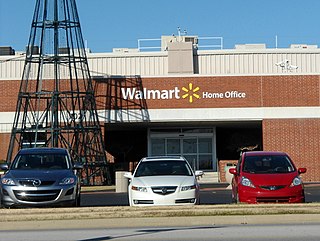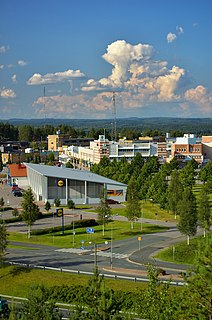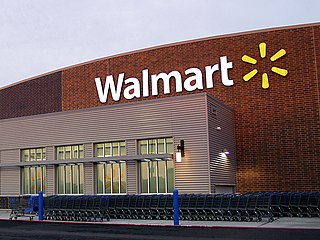
Walmart Inc. is an American multinational retail corporation that operates a chain of hypermarkets, discount department stores, and grocery stores from the United States, headquartered in Bentonville, Arkansas. The company was founded by Sam Walton in nearby Rogers, Arkansas in 1962 and incorporated under Delaware General Corporation Law on October 31, 1969. It also owns and operates Sam's Club retail warehouses.

A supermarket is a self-service shop offering a wide variety of food, beverages and household products, organized into sections. This kind of store is larger and has a wider selection than earlier grocery stores, but is smaller and more limited in the range of merchandise than a hypermarket or big-box market. In everyday U.S. usage, however, "grocery store" is synonymous with supermarket, and is not used to refer to other types of stores that sell groceries.

Retail is the sale of goods and services to consumers, in contrast to wholesaling, which is sale to business or institutional customers. A retailer purchases goods in large quantities from manufacturers, directly or through a wholesaler, and then sells in smaller quantities to consumers for a profit. Retailers are the final link in the supply chain from producers to consumers.

A grocery store (AE), grocery shop (BE) or simply grocery is a store that primarily retails a general range of food products, which may be fresh or packaged. In everyday U.S. usage, however, "grocery store" is a synonym for supermarket, and is not used to refer to other types of stores that sell groceries. In the UK, shops that sell food are distinguished as grocers or grocery shops.

A hypermarket is a big-box store combining a supermarket and a department store. The result is an expansive retail facility carrying a wide range of products under one roof, including full grocery lines and general merchandise. In theory, hypermarkets allow customers to satisfy all their routine shopping needs in one trip. The term hypermarket was coined in 1968 by French trade expert Jacques Pictet.
A discount store or discounter offers a retail format in which products are sold at prices that are in principle lower than an actual or supposed "full retail price". Discounters rely on bulk purchasing and efficient distribution to keep down costs.

Giant Eagle, Inc. and stylized as giant eagle) is an American supermarket chain with stores in Pennsylvania, Ohio, West Virginia, Indiana, and Maryland. The company was founded in 1918 in Pittsburgh, Pennsylvania, and incorporated on August 31, 1931. Supermarket News ranked Giant Eagle 21st on the "Top 75 North American Food Retailers" based on sales of $10 billion. In 2021, it was the 36th-largest privately held company, as determined by Forbes. Based on 2005 revenue, Giant Eagle is the 49th-largest retailer in the United States. As of Summer 2014, the company had approximately $9.9 billion in annual sales. As of Summer 2022, Giant Eagle, Inc. had 490 stores across the portfolio. 216 supermarkets and 274 fuel station/convenience stores under the GetGo banner. The company is headquartered in an office park in the Pittsburgh suburb of O'Hara Township.

A big-box store is a physically large retail establishment, usually part of a chain of stores. The term sometimes also refers, by extension, to the company that operates the store.
Organización Soriana is a Mexican public company and a major retailer in Mexico with more than 824 stores. Soriana is a grocery and department store retail chain headquartered in Torreón, Coahuila de Zaragoza, Mexico. The company is 100% capitalized in Mexico and has been publicly traded on the Mexican stock exchange, since 1987 under the symbol: "Soriana".
Hypermart USA was a demonstrator project operated by Walmart in the 1980s and 1990s, which attempted to combine groceries and general merchandise under one roof at a substantial discount. The hypermart concept was modeled after earlier efforts from other retailers, notably French retailers such as Auchan and Carrefour, and the Midwestern big retailer Meijer.

Bottom Dollar Food was an American soft-discount grocery chain. It was a subsidiary of Delhaize America, the U.S. division of international food retailer Delhaize Group. Its headquarters was in Salisbury, North Carolina.

Big C, is a grocery and general merchandising retailer headquartered in Bangkok, Thailand. Big C is as of 2016 Thailand's second-largest hypermarket operator after Lotus's. It has operations in four countries, namely Thailand, Vietnam, Laos and Cambodia.

Once the strategic plan is in place, retail managers turn to the more managerial aspects of planning. A retail mix is devised for the purpose of coordinating day-to-day tactical decisions. The retail marketing mix typically consists of six broad decision layers including product decisions, place decisions, promotion, price, personnel and presentation. The retail mix is loosely based on the marketing mix, but has been expanded and modified in line with the unique needs of the retail context. A number of scholars have argued for an expanded marketing, mix with the inclusion of two new Ps, namely, Personnel and Presentation since these contribute to the customer's unique retail experience and are the principal basis for retail differentiation. Yet other scholars argue that the Retail Format should be included. The modified retail marketing mix that is most commonly cited in textbooks is often called the 6 Ps of retailing.

The history of Walmart, an American discount department store chain, began in 1950 when businessman Sam Walton purchased a store from Luther E. Harrison in Bentonville, Arkansas, and opened Walton's 5 & 10. The Walmart chain proper was founded in 1962 with a single store in Rogers, expanding outside Arkansas by 1968 and throughout the rest of the Southern United States by the 1980s, ultimately operating a store in every state of the United States, plus its first stores in Canada, by 1995. The expansion was largely fueled by new store construction, although the chains Mohr-Value and Kuhn's Big K were also acquired. The company introduced its warehouse club chain Sam's Club in 1983 and its first Supercenter stores in 1988. By the second decade of the 21st century, the chain had grown to over 11,000 stores in 27 countries.
High–low pricing is a type of pricing strategy adopted by companies, usually small and medium-sized retail firms, where a firm initially charges a high price for a product and later, when it has become less desirable, sells it at a discount or through clearance sales.
Fleming Companies was founded as Lux Mercantile in Topeka, Kansas, in 1915 by O. A. Fleming, Gene Wilson and Samuel Lux. In 1921 the company's name was changed to Fleming-Wilson, and in 1941, the company name was changed to The Fleming Company, and Ned Fleming, son of O.A., was named president, chairman, and CEO. The company's IPO occurred in 1959, when 100,000 shares were offered. In 1981, R.D. Harrsion was elected Chairman and CEO of the company, with Dean Werries serving as President and COO. Starting in the 1960s, Fleming Companies began acquiring numerous grocery wholesalers and retailers, and it grew to become the nation's largest supplier of consumer packaged goods to U.S. retailers, serving approximately 50,000 retail locations. These locations included supermarkets such as IGA, convenience stores, supercenters, discount stores, concessions, limited assortment, drug, specialty, casinos, gift shops, military commissaries and exchanges and others. In the early 1990s, Fleming was the largest food wholesaler in the United States. The company served more than 3,500 supermarkets and other retail food stores in 42 states and the District of Columbia.

Kurt Jetta is a consumer researcher who studies data about multinational corporations through his firm, TABS Analytics, which is based in Shelton, Connecticut. The corporations Jetta has analyzed include Amazon, Family Dollar, Dollar Tree, Walmart, Apple, Kmart, JcPenney, and Sears. In addition, Jetta has also studied the organic food industry, the vitamin industry, and the online grocery industry. Other investigations led by Jetta include sociological research that pertains to the purchasing habits of various ethnic groups. In the area of trade promotion, Jetta has developed an alternative methodology to current industry baseline models. Jetta also analyzes rewards programs. He was a 2017 Republican candidate in Florida’s 21st Congressional District.
The Amazon Effect is the powerful disruption that eCommerce has made on the retail market. The term came about as a result of Amazon's dominant role in the eCommerce market place and leading the disruptive impact of the industry. The effect has been heavily researched by numerous studies including an in-depth Harvard study by Alberto Cavallo. The Amazon Effect has been found to cause numerous changes in the retail market. Among these impacts is an increase in price flexibility and uniform pricing in traditional brick-and-mortar stores. An externality of the increasing price flexibility and uniform pricing has been a decrease in pass-through inflation. Various other studies have revealed that the Amazon Effect has forced retail malls and offline retailers to create an experience around offline shopping in order to pull business away from eCommerce. Finally, it has been discovered that eCommerce has pushed retailer to increase their incorporation of technology to make offline shopping more convenient and quicker.
The retail format influences the consumer's store choice and addresses the consumer's expectations. At its most basic level, a retail format is a simple marketplace, that is; a location where goods and services are exchanged. In some parts of the world, the retail sector is still dominated by small family-run stores, but large retail chains are increasingly dominating the sector, because they can exert considerable buying power and pass on the savings in the form of lower prices. Many of these large retail chains also produce their own private labels which compete alongside manufacturer brands. Considerable consolidation of retail stores has changed the retail landscape, transferring power away from wholesalers and into the hands of the large retail chains.













